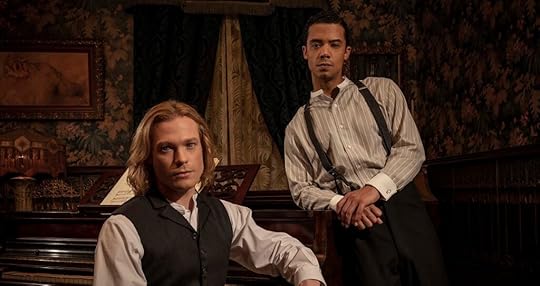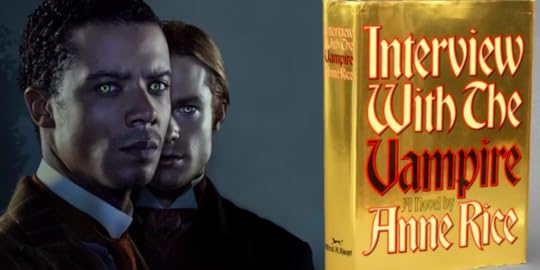We need to talk about Interview With the Vampire’s biphobia (Part 1: Bi erasure)

Amid rave reviews, praising the new AMC series for “finally letting the vampires be gay”, the conversation about the show’s treatment of bisexuality is silenced. To describe the show’s take on bisexuality in one word, it is complicated. Simultaneously erased, elevated, trodden down, associated with evil, seductiveness, villainy, privilege, freedom, and queerness. Laden with rich meaning, some of the scenes form a master class in cinematic storytelling through bisexuality, while others are the epitome of classic biphobia.
This is going to be a series of articles in which I show how Interview With the Vampire takes the source material’s bisexuality and turns it into ambivalent biphobia, by depicting it as simultaneously oppressive and liberatory. I’ll explore bisexual erasure, the meanings given to bisexuality, and explain how these ultimately reveal bisexuality’s subversive power against dominant social structures.
Let me start with a disclaimer.
Just so we’re clear – this is a great showThough much complaint is heard from fans of the Anne Rice books for deviating from the original, critics have been praising this show to no end – and justifiably so. The show’s irreverent treatment of the source material is nothing short of a stroke of genius. The showrunners took the original book and ran with it. They spun it into a retelling that is fresh and original, standing on the shoulders of a giant to create something new, while still preserving the core, the heart of the story.
Specifically, the choice of making Louis – originally a slave plantation owner – black, brings a whole new level of meaning, depth, and complexity into the narrative. It exposes the viewers to a culture and experience that the source material could never dream of. It also makes for a brilliant solution to the problem of depicting a white plantation owner as the romanticized protagonist of the story, by literally turning the book’s racism on its head.
Even as its own text, without regard to the source material, this show does its job incredibly well. It’s well narrated, written, and acted. Its beautiful cinematography makes every episode a delight to behold. It is completely legible to people who haven’t read the book, while still adding easter eggs and meta commentary on the original that both enriches and subverts it.
On the whole – I fucking love it.
And therein lies the problem – when something that does so very well on literally every level fails so hard in this.
 Bisexuality in the book
Bisexuality in the book[Book spoilers]
Interview With the Vampire is a very bisexual book. Though very little is explicit and on the surface, the subtext is rich with it. From the outset, the interview itself between Louis and Daniel takes place after they cruise each other and then go to Louis’ apartment. Most of the book/the interview itself focuses on his relationship with Lestat, starting with courtship and ending with an embivalent breakup. In addition, Louis tells about his love for a woman named Babette Freniere, which continues even after Lestat turns him into a vampire. When Louis and Lestat turn Claudia, Louis’ feelings towards her aren’t just fatherly, as in the show, but also romantic (yes, Anne Rice has a penchant for p*dophilia). Their relationship is consistently described in terms that blend and obscure the boundary between fatherly and romantic love. At one point in the book, while talking to Louis, Armand calls her “Your lover”, to which Louis replies: “No, my beloved”, emphasizing the complexity and multiplicity of Louis and Claudia’s relationship and feelings for one another. All the while, during this part of the book, Armand also is trying to court Louis (ultimately successfully, once Claudia dies). So, Louis is bisexual.
Moving on, both Interview With the Vampire and the Vampire Chronicles book series in general, make it abundantly clear that Lestat is bisexual. In Interview, he continues to feed on men and women, where bloodsucking is invariably described as erotic in Anne Rice’s books – both with the refrain that feeding replaces sex for vampires, and through the erotic language used to describe the act. Lestat is the one to seek out the relationship with Louis and turn him into a vampire. And throughout the Vampire Chronicles, Lestat has relationships, both romantic and erotic, with several women and men.
Daniel is also bisexual. During the Vampire Chronicles, he is shown to have relationships with Armand and Marius, and Anne Rice has spoken multiple times to the fact that all her vampires “transcend gender in their orientation”.
The book is not biphobic in its representation and storytelling. Don’t get me wrong, one can certainly make a case about the fetishization of male bisexuality in the books. It also, of course, links between bisexuality and vampirism, a well rich with meanings that by association imagine bisexuality as innate (the problematic notion that “everyone is bisexual really”), and as predatory and monstrous, dejected and dangerous. The latter meanings, though lovely when reclaimed, carry negative cultural meaning, therefore revealing a negative attitude and fear of bisexuality (=biphobia)*. But because Anne Rice’s vampires are all bisexual, and because they are humanized, romanticized, and eroticized, this doesn’t carry over to a strong negative characterization of bisexual vampire characters.
The show messed this up. And it starts with bisexual erasure.
[* Saying this is not, in fact, biphobic, nor is it a form of respectability politics. It becomes respectability politics when in response, we demand that bisexual characters be made respectable. Pointing out biphobic tropes , in itself, is not biphobic. Honestly this shouldn’t need explaining, but here we are.]
 One bi character left standing
One bi character left standingOut of three bisexual main characters, only one is left. Where it had the choice of staying true to the bisexual source, the show chooses to erase both Louis and Daniel’s bisexuality – Louis is made gay while Daniel is made straight. First and foremost, this change betrays somewhat of a bifurcated perception of bisexual identity and attraction, i.e. imagining it as “half gay” and “half straight”. One can imagine that the showrunners thought this change made sense as they chose which “half” to go with for each character.
We can only guess what motivated the showrunners to make this change. One option is that they wanted to tick more representation boxes. They knew the series would receive greater acclaim if one of the characters would be “fully gay” rather than just “half”, i.e. bisexual. They may have also felt they were being more faithful to the source material by doing so – as the rave reviews say, letting the story be “actually gay”. Similarly to the above, these two notions also reflect the belief that bisexuality is only “half”, that it is not “fully queer”, or that it’s a “cop out”.
Another reason why leaving Lestat as bisexual while making Louis gay might have made “more sense” to the showrunners is that Lestat is to a large extent the villain while Louis is the victim. The range of meanings associated with bisexuality in culture means people feel more comfortable seeing bi characters in villainous roles, it “makes sense” for people to associate bisexuality with evil. Whereas this has also been the case for representations of gay people in the past, it has overwhelmingly changed over the last 20 years. Though queer coding villains is still a prevalent practice, explicitly gay characters are not so often cast in such a role anymore. But bi characters are.
Yet another possible reason for this is the association between bisexuality and whiteness. After making Louis black, it might have made “less sense” to the showrunners for him to be bisexual, since bisexuality is widely perceived as a white identity (ironically enough, as statistically, bi people are disproportionately people of color). Meanwhile blackness, like gayness, is an oppressed identity that is actually perceived as oppressed. Therefore it makes “more sense” for the black character to bear a gay identity, while the white character is allowed to remain bisexual as an imagined marker of “privilege”.
On a more sympathetic note, one can also imagine the showrunners may have wanted to avoid the “everyone is bisexual” trope which is broadly present in the source material. As I noted above, this trope suggests that everyone is actually bisexual. It consigns bisexuality to an eternally latent status, always lurking underneath, but never present in the here and now. Combined with vampirism, it suggests that bisexuality is only possible when one exists outside of society and is able to live a long life. It also imagines bisexuality as supernatural and inhuman.*
[* Again, pointing this out is not biphobic, see above.]
[TW: discussion of p*dophilia]
Another valid reason why the showrunners may have chosen to do this is avoiding the p*dophilic tones in Louis and Claudia’s relationship. Anne Rice was openly supportive of p*dophilia, which is deeply disturbing. In the 1994 film, there is actually a scene where Kirsten Dunst and Brad Pitt kiss. She was 12 at the time, while he was 29. So I’m genuinely glad and relieved that they decided to leave that part out. However, they absolutely could have done that while letting Louis stay bisexual.
[End of TW]
Whatever the reason, making Lestat the only bisexual character makes him the focal point of bisexuality in the show. He remains to represent it alone, meaning that his depiction, his actions, and his function in the plot make up the whole of the show’s commentary on bisexuality. And the meanings given to his bisexuality in many ways echo the points made above.
In the next part, we’ll delve into the many and complicated meanings that the show attributes to bisexuality through Lestat’s character.
Shiri Eisner's Blog
- Shiri Eisner's profile
- 33 followers



